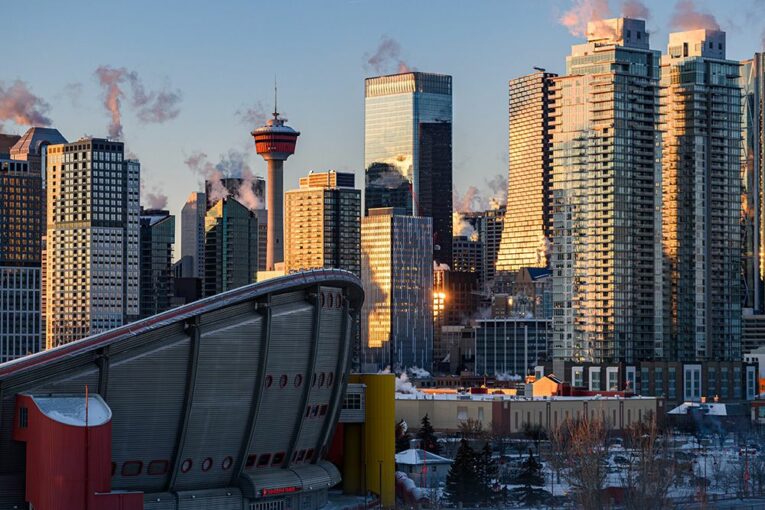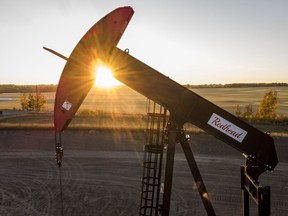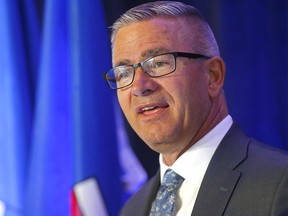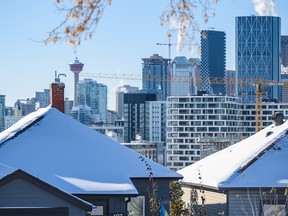
Is Alberta’s holiday punch bowl half full, or half empty, for 2023?
It’s all about perspective.
The encouraging news for Albertans heading into a new year is the province is expected to lead Canada in economic growth. Jobs will still be created, even as recessionary headwinds whip across the country.
The bleaker view is economic growth and employment gains will slow significantly after revving up in 2022.
The jobless rate is forecast to increase slightly, while stubbornly high inflation, rising interest rates and an expected global slowdown hit home.
A new TD Economics report projects Alberta’s economy will expand by 1.9 per cent in 2023, a significant cooling from the 5.1 per cent growth this year that was powered by rising commodity prices.
Yet, even a modest economic expansion should earn Alberta the mantle of top performer in the country, running slightly ahead of second-place Saskatchewan, while the broader Canadian economy is expected to teeter on the brink of a recession.
“This is pretty much an oil story,” TD economist Rishi Sondhi said of Alberta’s forecast, noting energy prices are projected to remain elevated in 2023.
“You’ve got to remember the oil and gas sector, when it’s humming along, has some beneficial spinoffs for other industries . . . A rising tide lifts all boats.”

Prices for benchmark U.S. oil climbed above US$100 a barrel this year following Russia’s invasion of Ukraine, before settling around $75 for much of December.
TD anticipates West Texas Intermediate (WTI) crude will average about $88 a barrel next year, while North American natural gas prices will remain high at $5.80 per million British thermal units.
Expectations of continued strength in the oilpatch are driving optimism among business owners, said Alberta Chambers of Commerce CEO Shauna Feth.
Oil production is still growing and spending is expected to rise. The $21.4-billion Trans Mountain pipeline expansion project is expected to be completed later in 2023.
A recent chamber survey of business operators found slightly more than two-thirds say they’re positive about Alberta’s long-term future, up from 43 per cent a year ago.
And almost half — 46 per cent — anticipate increasing their workforce during the next year. Only four per cent believe it will shrink.
However, the poll also found more than three-quarters expect a recession in 2023.
“We know it’s going to be a challenging year,” Feth said. “But, generally, the business community in Alberta is very positive.”
Recommended from Editorial
-

‘A positive for the economy’: Interprovincial migration continues to rise in Alberta
-

Varcoe: ‘No margin of error’ — Keystone shutdown a reminder of pipeline capacity crunch
-

Calgary rents spike 22 per cent in one year, third-highest rise in Canada
-

Government offers more details on Alberta’s inflation relief program
-

Varcoe: Global recession looms, but Alberta forecasts continued growth into 2023 even with oil price risks
-

Why handing out cash to help people manage inflation only makes it worse
-

‘Not a luxurious lifestyle’: $22.40 an hour is deemed to be living wage in Calgary
Another point to consider is what’s going on around the Canadian landscape.
TD is projecting the country’s gross domestic product (GDP) to grow by a tepid 0.7 per cent in 2023.
“While the country is heading into some pretty significant headwinds in terms of the economy, the Alberta economy is looking to be much more resilient and it should continue to grow,” Finance Minister Travis Toews said in an interview.
“Employers across the province are looking for help. There are incredible opportunities right now in Alberta if you’re looking for a job.”

An increase in Alberta’s GDP next year is welcome, but the labour market outlook in the province is not quite so certain.
TD Economics said employment, which will grow by five per cent this year, will decelerate, climbing by less than one per cent in 2023.
And the unemployment rate, which sat at 4.8 per cent in the summer and jumped to 5.8 per cent in November, will average 6.1 per cent in 2023.
Consumer spending is also expected to weaken.
Housing starts in the province, up 19 per cent through the first 11 months of 2022, will cool next year, expected to dip by seven per cent, according to TD.
Prices for Alberta homes, which have been affected recently by rising mortgage costs, are forecast to drop by 5.6 per cent next year, about half of the national decline forecasted by the study.
Other housing markets have been hit by a correction — after seeing bigger gains in recent years — but Alberta has experienced less of a whipsaw.
“We’re not expected to see the same level of pullback” as in other markets, said Ann-Marie Lurie, chief economist at the Calgary Real Estate Board.
“We still have a lot of job vacancies in this province and all of that will help cushion some of the impacts that higher (interest rates) are going to have.”
In Calgary, the benchmark housing price reached a new high of $546,000 in May, before dropping in the second half of the year, averaging $520,200 last month.

Meanwhile, the province’s population continues to rise, which should support the housing market.
Between July and the end of September, the province saw the fastest three-month growth rate from interprovincial migration since the same period in 1980. More people were relocating to Alberta from Ontario, British Columbia and Manitoba.
“Canadians are voting with their feet,” said Toews.
The TD forecast also notes that significant provincial inflation relief for households is coming as this year’s budget surplus is expected to top $12 billion.
The province has plenty of capacity for additional spending or to increase its savings. Premier Danielle Smith isn’t signalling that broad-based tax cuts will be included in the 2023 provincial budget.
In a year-end interview, she said paying down long-term debt remains a priority.
“We can’t continue to have this high level of debt in a rising interest rate environment, but there are some significant cost pressures, not just on the infrastructure side but also on the affordability side,” Smith added.
“I’d be very surprised if the finance minister proposed a significant tax cut. There will be some targeted measures.”
Chris Varcoe is a Calgary Herald columnist.
You can read more of the news on source
